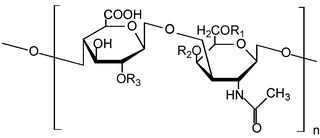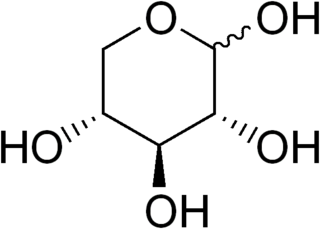Related Research Articles

Glycosaminoglycans (GAGs) or mucopolysaccharides are long, linear polysaccharides consisting of repeating disaccharide units. The repeating two-sugar unit consists of a uronic sugar and an amino sugar, except in the case of the sulfated glycosaminoglycan keratan, where, in place of the uronic sugar there is a galactose unit. GAGs are found in vertebrates, invertebrates and bacteria. Because GAGs are highly polar molecules and attract water; the body uses them as lubricants or shock absorbers.

Heparan sulfate (HS) is a linear polysaccharide found in all animal tissues. It occurs as a proteoglycan in which two or three HS chains are attached in close proximity to cell surface or extracellular matrix proteins. In this form, HS binds to a variety of protein ligands, including Wnt, and regulates a wide range of biological activities, including developmental processes, angiogenesis, blood coagulation, abolishing detachment activity by GrB, and tumour metastasis. HS has also been shown to serve as cellular receptor for a number of viruses, including the respiratory syncytial virus. One study suggests that cellular heparan sulfate has a role in SARS-CoV-2 Infection, particularly when the virus attaches with ACE2.

In enzymology, a galactosylgalactosylxylosylprotein 3-beta-glucuronosyltransferase is an enzyme that catalyzes the chemical reaction
In enzymology, a galactosylxylosylprotein 3-beta-galactosyltransferase is an enzyme that catalyzes the chemical reaction
In enzymology, a glycoprotein 2-beta-D-xylosyltransferase (EC 2.4.2.38) is an enzyme that catalyzes the chemical reaction
In enzymology, a N-acetylgalactosaminyl-proteoglycan 3-beta-glucuronosyltransferase is an enzyme that catalyzes the chemical reaction
In enzymology, a N-acetylglucosaminyl-proteoglycan 4-beta-glucuronosyltransferase is an enzyme that catalyzes the chemical reaction
In enzymology, a xylosylprotein 4-beta-galactosyltransferase is an enzyme that catalyzes the chemical reaction
In enzymology, a zeatin O-beta-D-xylosyltransferase is an enzyme that catalyzes the chemical reaction
In enzymology, a xyloglucan 4-glucosyltransferase is an enzyme that catalyzes the chemical reaction in which a beta-D-glucosyl residue is transferred from UDP-glucose to another glucose residue in xyloglucan, linked by a beta-1,4-D-glucosyl-D-glucose bond.
In enzymology, a xyloglucan 6-xylosyltransferase is an enzyme that catalyzes the chemical reaction in which an alpha-D-xylosyl residue is transferred from UDP-D-xylose to a glucose residue in xyloglucan, being attached by an alpha-1,6-D-xylosyl-D-glucose bond.

Xylosyltransferase 1 is an enzyme that in humans is encoded by the XYLT1 gene.

Galactosylgalactosylxylosylprotein 3-beta-glucuronosyltransferase 3 is an enzyme that in humans is encoded by the B3GAT3 gene.

Xylosyltransferase 2 is an enzyme that in humans is encoded by the XYLT2 gene.

Xylosyltransferase are transferase enzymes which act upon xylose and are classified under EC 2.4.2.
A xyloside is a type of glycoside derived from the sugar xylose.
Glucuronylgalactosylproteoglycan 4-beta-N-acetylgalactosaminyltransferase is an enzyme with systematic name UDP-N-acetyl-D-galactosamine:D-glucuronyl-(1->3)-beta-D-galactosyl-proteoglycan 4-beta-N-acetylgalactosaminyltransferase. This enzyme catalyses the following chemical reaction
Glucuronosyl-N-acetylgalactosaminyl-proteoglycan 4-beta-N-acetylgalactosaminyltransferase is an enzyme with systematic name UDP-N-acetyl-D-galactosamine:beta-D-glucuronosyl-(1->3)-N-acetyl-beta-D-galactosaminyl-proteoglycan 4-beta-N-acetylgalactosaminyltransferase. This enzyme catalyses the following chemical reaction
Xylogalacturonan beta-1,3-xylosyltransferase is an enzyme with systematic name UDP-D-xylose:xylogalacturonan 3-beta-D-xylosyltransferase. This enzyme catalyses the following chemical reaction
UDP-D-xylose:beta-D-glucoside alpha-1,3-D-xylosyltransferase is an enzyme with systematic name UDP-alpha-D-xylose:beta-D-glucoside 3-alpha-D-xylosyltransferase. This enzyme catalyses the following chemical reaction
References
- Stoolmiller AC, Horwitz AL, Dorfman A (1972). "Biosynthesis of the chondroitin sulfate proteoglycan. Purification and properties of xylosyltransferase". J. Biol. Chem. 247 (11): 3525–32. PMID 5030630.
- Gotting C, Kuhn J, Zahn R, Brinkmann T, Kleesiek K (2000). "Molecular cloning and expression of human UDP-d-Xylose:proteoglycan core protein beta-d-xylosyltransferase and its first isoform XT-II". J. Mol. Biol. 304 (4): 517–28. doi:10.1006/jmbi.2000.4261. PMID 11099377.